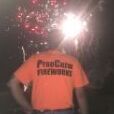If you want to run a fan from battery, something such as this would be ideal.
https://gpelectric.com/products/1500-watt-industrial-pure-sine-wave-inverter/
It will follow the normal rules of any transformer-like device. With 12V input and 120V output, it has a 10:1 ratio. In other words, the voltage is multiplied by 10 as viewed going from the battery to the load; and the current is multiplied by 10 as viewed from the load to the battery. Watts of real-power will remain the same, minus the 5% efficiency loss.
So, a resistive load such as a light bulb which draws 1 amp at 120V from the inverter will cause the inverter to draw 10 amps at 12V from the battery; plus efficiency losses.
A 10 amp resistive load such as a coffee maker requires 100 amps from the battery, plus efficiency losses.
AC Motor loads (even series / universal motors) have an inductive nature which can damage cheap inverters, but works well with pure-sine inverters. To predict the battery current demand for a motor through an inverter, you need to know the watts of power demand for the motor. Then use the formula: ([Motor Power] / [battery Volts]) / [Inverter efficiency] = [Battery Amps]
Motor Power is Watts as measured by a watt-meter which is aware of power factor; such as a Kill-A-Watt meter. This is not amps nor VA; and one cannot measure volts and amps separately to calculate this with an AC motor of any type.
Inverter Efficiency is per-unit efficiency. If the inverter claims a 95% efficiency that is 0.95 per-unit. Per-unit (PU) is simply percent divided by 100. PU is "per one" whereas percent is "per 100." PU a common unit of measurement with electrical parameters.
Most of the vintage tabletop fans use less than 100W, often a lot less. If your fan uses 40W of power, and your inverter is powered by a 12V battery, you can use the formula as follows:
40 W Power (measured with Kill-A-Watt)
0.95 Efficiency (from inverter documentation)
12V Battery (nominal battery voltage)
(40/12)/0.95=3.51
Therefore, to run a fan requiring 40W from a 95% efficient inverter from a 12V battery, the battery will have to supply about 3.5 amps.
For a 100W fan, you would be using about 8.8 A from the battery.
If you have a fully charged 100AH 12V deep-cycle battery, it can supply 5A for 20 hours, based on the normal way they are rated. The higher the rate of discharge the less of the energy you recover from the battery, but if you stay within the current range for a 10 to 20 hour discharge, they reasonably hold true to the following formula:
Run Time = (battery capacity) divided by (battery current)
For the two examples of fans above, the 100AH 12V battery would support the fan as follows...
100 AH battery
40W fan
12V battery
95% efficient inverter 100/((40/12)/0.95)=28 hours
100 AH battery
100W fan
12V battery
95% efficient inverter 100/((100/12)/0.95)=11 hours (or slightly less because this is a higher rate of discharge than the 20 hour rate upon which the battery is rated)
These numbers are just approximations, but they are probably "in the ballpark" for for not having actual equipment to test.
Hope y'all found this interesting! 🙂

